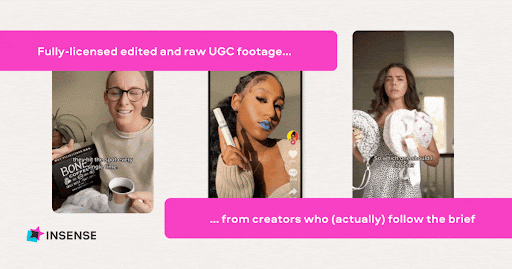The future of SEO explained
🔍 SEO vs GEO and AIO explained in depth, while unstructured data drives sharper strategies

Hey there 🧠
Ready for another day of staying ahead of the competition in the Growth race?
Oh and before we go ahead! If your friend sent this to you, be sure to subscribe here! So you don’t miss out on any editions.
Partnership with Insense
Ship. Brief. Launch. UGC That Goes Live in 48 Hours.

The right UGC cuts acquisition costs in half and 4× your ad CTRs, but only if the creators follow the playbook.
Trying to manage that manually? Burnout guaranteed.
Insense gives you instant access to a global pool of 68,500+ micro-influencers and UGC specialists, pre-vetted, pre-briefed, and performance-proven across 35+ countries.
Top brands use Insense to run seamless campaigns from product seeding and gifting to TikTok Shop and affiliate campaigns, and whitelisted ads.
- Nurture Life cut turnaround time from 2 months to 2 weeks using just one marketer and Insense
- Solawave received 180+ ad-ready assets in a single month by simply shipping products
- Matys Health achieved 12× reach through Spark Ads on TikTok
Want to skip sourcing chaos and launch faster?
Book your free strategy call before Sept 19th and get a $200 bonus for your first campaign!
Book your free strategy call (Button hyperlink with )
💡 SEO vs GEO, AIO, and More
Acronyms spread quickly in marketing, and AI has only accelerated the trend. With the rise of generative tools, terms like GEO, AEO, LLMO, and AIO are popping up everywhere. But at the core, they all describe the same idea: optimizing content to appear in AI-driven answers.
1️⃣ What the Acronyms Mean:
- GEO: Generative engine optimization
- AEO: Answer engine optimization
- LLMO: Large language model optimization
- AIO: Artificial intelligence optimization
Each one refers to positioning your brand so it appears in responses from systems like ChatGPT or Google’s AI Mode.
2️⃣ Why So Many Acronyms Exist: The space is new, and everyone wants to coin a term that stands out. Yet the reality is that most of these strategies overlap with one another and with SEO itself.
3️⃣ SEO Still Matters: Search demand for “SEO” is still far ahead of these newer terms and has even grown in the past year. The fundamentals remain unchanged: strong, authoritative, high-quality content is still what wins.
4️⃣ What’s Actually Different: AI optimization does shift some priorities:
- Citations become as important as backlinks
- Tracking brand mentions in AI answers is a new KPI
- Research now includes questions people ask AI systems
- Content must have quotable passages that give clear, direct answers
The Takeaway
Do not let hype around new acronyms distract you. SEO remains essential, and AI optimization is simply an updated form of it. The brands that will win are those that consistently create helpful, trustworthy, and authoritative content.
💡 Smarter B2B Content Marketing With Unstructured Data
In B2B, the most valuable content insights do not live in dashboards. They are hidden in unstructured data such as customer reviews, Slack threads, and sales call transcripts. According to Robynn Farrell, this is the goldmine most marketers overlook.
1️⃣ Where the Insights Live: Your customers are already giving you the language you need. Support tickets, sales docs, LinkedIn discussions, and call transcripts contain raw feedback that reveals pain points and opportunities better than keyword tools.
2️⃣ Why It Matters: If you are not using this data, your competitors might be. AI models train on public insights, which allows them to become the default trusted voices in your industry. Without tapping into your own channels, you risk losing authority in your space.
3️⃣ How to Start Mining:
- Tag pain points manually to capture nuance
- Use AI to surface recurring themes
- Automate collection from touchpoints like support and sales calls
- Store findings in a searchable database
4️⃣ Turning Data Into Content: Transform quotes and themes into a strategy by:
- Using customer quotes for headlines
- Grouping insights by topic for blogs or reports
- Repurposing transcripts into multi-format thought leadership content
5️⃣ Spotting Trends Early: Keyword tools often lag behind. Unstructured data shows the earliest signs of market shifts, letting you detect patterns before rivals and establish authority in conversations from the beginning.
The Takeaway
The strongest B2B content strategies are built on unstructured data. Mining it is not optional. It is the foundation for authority and trust in an AI-first world. Those who use it wisely will build content moats long before competitors notice the trend.
As we prepare more "Growthful" content, we'd love to hear your thoughts on today's edition! Feel free to share this with someone who would appreciate it. 🥰